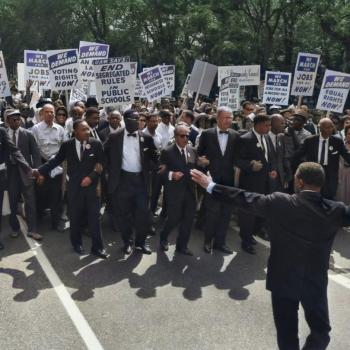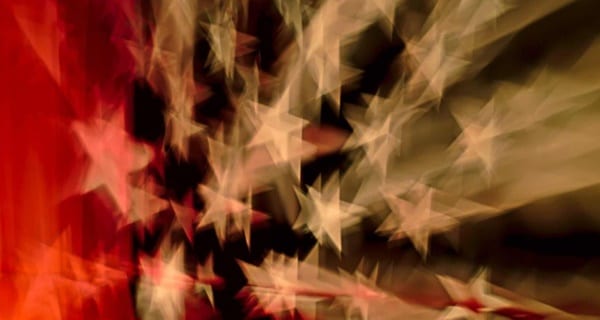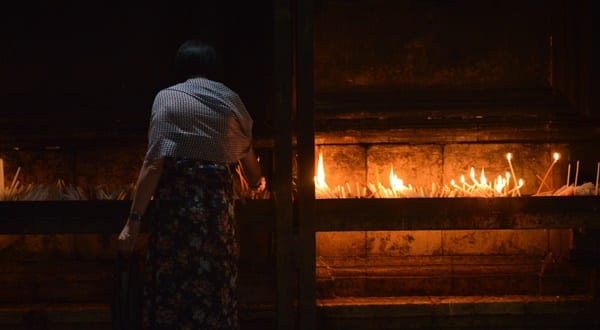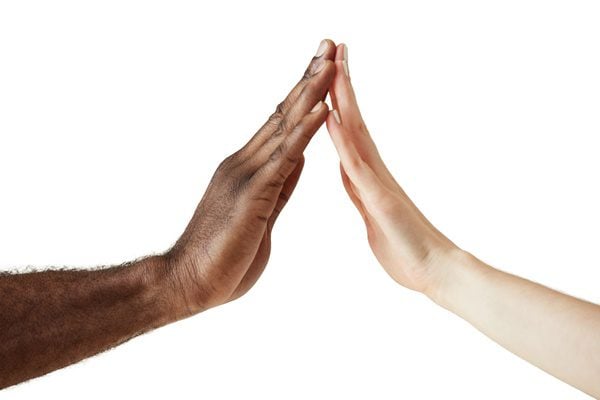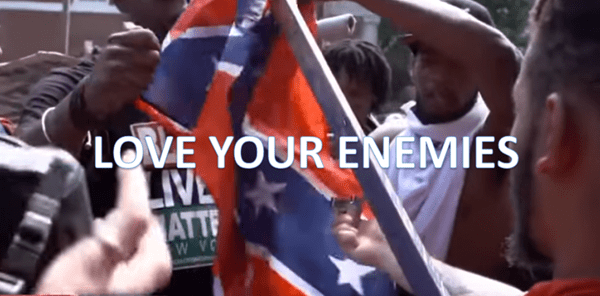 The title question is not rhetorical, and I don’t have an easy answer. I am struggling with Jesus’s call to love both the “enemy” and the vulnerable at a time when the violent undercurrents that propel the United States on her reckless, destructive course are bubbling to the surface and erupting in conflict. I know that love is the only power that can transform hate. Yet, while the command to love neighbor and enemy alike is clear and the imperative to do so to revitalize a dying world is urgent, the question of how best to show that love shakes me to my core with confusion.
The title question is not rhetorical, and I don’t have an easy answer. I am struggling with Jesus’s call to love both the “enemy” and the vulnerable at a time when the violent undercurrents that propel the United States on her reckless, destructive course are bubbling to the surface and erupting in conflict. I know that love is the only power that can transform hate. Yet, while the command to love neighbor and enemy alike is clear and the imperative to do so to revitalize a dying world is urgent, the question of how best to show that love shakes me to my core with confusion.
These are precarious times for marginalized people in the United States. Yet a subset of those most protected by our nation’s laws and social structures – educated white men – marched along the streets of Charlottesville chanting “You will not replace us” as if their lives and livelihoods were under threat. Though their rally was meant to intimidate, their own fear came through their words.
White men are in no danger of being replaced. If the arc of history indeed bends toward justice, then the racist systems now being exposed will be replaced, to the benefit of everyone, including white supremacists who now feel threatened. Yet we cannot over-estimate the progress that has been made or deny that in some ways it is sliding backward. The underlying racist structure of our nation is continually reinforced as racial minorities are disproportionately arrested and killed, the wage gap between white Americans and African Americans is the worst it’s been in 40 years, and schools continue to teach a predominately Euro-centric curriculum.
This is the backdrop to Charlottesville, where white supremacists clashed with peaceful protesters as well as militant antiracist Antifa members over a weekend in mid-August. That Friday night, those who marched to the statue of Thomas Jefferson not only carried torches, but (some) also beat people with them. That Saturday, some white supremacists carried guns, and one shot at protesters in full view of police, in addition to the vehicular violence that killed Heather Heyer. In this context that, while I don’t believe in violence, I feel grateful for people who did what was necessary to save their lives and the lives of others. I listen when Dr. Cornel West and clergy members say Antifa saved their lives. And rather than judge defensive violence, I want to focus my peacemaking efforts on making all violence unnecessary.
And this is where trying to love my enemies comes in. Jesus’s command to love enemies is not just a dogma for the faithful; it is a practical guide to transforming a world of fear and distrust to one of compassion and reconciliation. Whereas hate perpetuates violence, love can heal it. I can find it in my heart to love those who do considerable harm – to acknowledge them as children of God and recognize that the image of Love must be extracted from an identity built on false-superiority and dehumanization of the “other.” What is harder to muster than love, however, is empathy. I think a degree of understanding and imagining one’s self in the shoes of another is necessary for showing love and entering into healing. But it is hard to empathize with those whose sense of reality is riddled with lies and misunderstandings.
Yet I know that I also have my blindspots and ways in which I hurt people in my ignorance. Being aware of my own need for forgiveness helps me to summon patience and compassion. From there, I ask myself how our national climate of hostility that produces such militant white supremacy may be best understood and changed.
Here are a few things I know:
- The United States is obsessed with exceptionalism. There is a pseudo-righteous pride in defining ourselves as a nation over and above all others. Racism functions in a similar manner and is deeply rooted our nation’s culture and history. Perhaps the belief in racial superiority could be mitigated if we didn’t cultivate such a toxic nationalism and exceptionalism. Our self-respect as a nation should be nurtured as a belief that we are part of an interconnected world, with a beautiful and diverse humanity. We could cultivate pride not in ourselves apart from others but in doing our part to nurture the whole world and her people, while simultaneously cultivating a sense of gratitude to other nations and peoples. Furthermore, we should take steps to transition from a culture of competition to one of cooperation and collaboration, so that we can find our identities not over and against, but with and for.
- Education does not necessarily quell racism, as college students and graduates leading the white supremacist marches at Charlottesville proved. But schools could do a much better job teaching the cultures and contributions of people of color from kindergarten through high school. Furthermore, schools could be far more honest about the evils of slavery and segregation, and teach children how their lasting effects contribute to de-facto segregation of neighborhoods and income inequality to this day. Ignorance about these issues nurtures prejudice; knowledge enhances compassion.
- White people need positive anti-racist role models. While studies of Civil Rights should absolutely center on role models of color, anti-racist allies should also be studied to encourage white people in their essential roles of transforming systemic racism into true equality. Seeing specifically anti-racist white role models can help white people coming to terms with the horror and pervasiveness of racism transition from possible feelings of guilt and resentment (which only exacerbate the problem) to hope and action.
- We must acknowledge the connection between racism and militarism and work to end our wars. Militarism abroad fuels distrust and enmity at home. The fact that the majority of people the United States kills in our countless, endless wars are dark-skinned further fuels racism and enmity. Excess military equipment spilling onto our streets and used in predominately minority neighborhoods reinforces stereotypes that people of color are dangerous even as they are the ones who are endangered. Moreover, the countless resources lost to war contribute to economic insecurity that exacerbates tensions and leads people to take out their frustrations on scapegoats in a nation that is built on the scapegoating of people of color.
Knowing that I have a role to play in cultivating a culture of compassion rather than enmity helps me channel my energy from anger to action. Knowing that racism is so deep and pervasive that I must constantly strive against passive acquiescence to it helps me to concentrate on my own responsibility rather than define myself against (or scapegoat) white supremacists. My hope is that nurturing a culture of awareness and compassion will decrease inclinations toward self-aggrandizement and superiority, treating the disease of white supremacy while healing the patients and building a more just world for all.
This vision guides me as I strive to love people of color and white supremacists at the same time. For while love of enemies is hard, it is the only path to transformation. But how can a long-term vision of reconciliation and healing help in the moment when violence comes to a head?
In moments of confrontation it may not be possible to show love to both sides. Having love is possible, but showing it to two conflicting sides simultaneously is harder. There can be no equivocation: we must stand with people of color against white supremacy. And while we can point out the counterproductivity of violence, even if we’re ready to renounce self-defense and put our bodies on the line to absorb possible violence, we cannot demand the same of anyone else.
What we can do, though, is petition our legislators to pass laws banning weapons at free speech rallies or marches. No one should be allowed to march with torches, let alone guns. Violence is not speech. Trying to prevent violence is one way to show love to all sides.
We can also carry signs with messages like, “There Is Life Beyond Hate.” Messages that show that we stand with our sisters and brothers of color but also have faith in the goodness of all humanity, including those who march against us. We could pass out fliers of support groups like “Life After Hate,” or put their web addresses on our signs. There are those who, deep inside, know that racism is wrong and may double-down on hateful rhetoric and action more to find a sense of group-belonging than out of their own ideals. They need help climbing out of the abyss of hate, and signs that show mercy rather than condemnation could give them the hope they need.
These are just a few ideas for transforming a world of enmity and keeping love for everyone in focus. I have further ideas specifically for the church, which I hope to share soon. But first I want to hear from you.
How do you heed the call to love enemy and neighbor alike when it comes to transforming white supremacy and healing racism?
Image: Screenshot from Youtube: “Who are the white supremacists and Antifa: Part 1” by ABC News. Image modified.
Stay in the loop! Like Teaching Nonviolent Atonement on Facebook!


